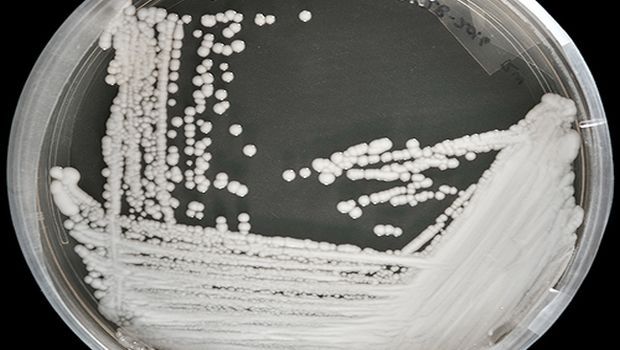Ongoing Transmission of Candida auris in Healthcare Facilities
In June 2016, the Centers for Disease Control and Prevention (CDC) released a clinical alert about the emerging, and often multidrug-resistant, fungus Candida auris and later reported the first seven U.S. cases of infection through August 2016 (1). Six of these cases occurred before the clinical alert and were retrospectively identified. As of May 12, 2017, a total of 77 U.S. clinical cases of C. auris had been reported to CDC from seven states: New York (53 cases), New Jersey (16), Illinois (four), Indiana (one), Maryland (one), Massachusetts (one), and Oklahoma (one). All of these cases were identified through cultures taken as part of routine patient care (clinical cases).


Cases as of May 12, 2017. Courtesy of the CDC
In June 2016, the Centers for Disease Control and Prevention (CDC) released a clinical alert about the emerging, and often multidrug-resistant, fungus Candida auris and later reported the first seven U.S. cases of infection through August 2016 (1). Six of these cases occurred before the clinical alert and were retrospectively identified. As of May 12, 2017, a total of 77 U.S. clinical cases of C. auris had been reported to CDC from seven states: New York (53 cases), New Jersey (16), Illinois (four), Indiana (one), Maryland (one), Massachusetts (one), and Oklahoma (one). All of these cases were identified through cultures taken as part of routine patient care (clinical cases).
Screening of close contacts of these patients, primarily of patients on the same ward in healthcare facilities, identified an additional 45 patients with C. auris isolated from one or more body sites (screening cases), resulting in a total of 122 patients from whom C. auris has been isolated. Among the 77 clinical cases, median patient age was 70 years (range = 21–96 years), and 55% were male. C. auris was cultured from the following sites: blood (45 isolates), urine (11), respiratory tract (eight), bile fluid (four), wound (four), central venous catheter tip (two), bone (one), ear (one), and a jejunal biopsy (one). Antifungal susceptibility testing at CDC of the first 35 clinical isolates revealed that 30 (86%) isolates were resistant to fluconazole (minimum inhibitory concentration [MIC] >32), 15 (43%) were resistant to amphotericin B (MIC ≥2), and one (3%) was resistant to echinocandins (MIC >4). Most (69, 90%) clinical cases were identified in the New York City metropolitan area (53 in New York and 16 in New Jersey). Nearly all patients had multiple underlying medical conditions and extensive healthcare facility exposure. Epidemiologic links have been found between most cases. In Illinois, three cases were associated with the same long-term care facility. In New York and New Jersey, cases were identified in multiple acute care hospitals, but further investigation found most had overlapping stays at interconnected long-term care facilities and acute care hospitals within a limited geographic area. The case in Massachusetts was linked to the Illinois cases. The cases in Indiana and Oklahoma occurred in patients who had recently received healthcare in other countries.
Tsay and Welsh, et al. (2017) report that, "Ongoing investigation of U.S. C. auris cases provides epidemiologic and laboratory data suggesting that this fungus can spread within healthcare facilities and that interventions are needed to prevent transmission during this early stage of C. auris emergence. As of May 2017, recognized U.S. C. auris cases were concentrated in healthcare facilities in three separate geographic areas, and most cases were in chronically ill patients with long stays at high-acuity skilled nursing facilities (e.g., facilities providing mechanical ventilation). Apart from one case identified in 2013, clinical laboratories serving healthcare facilities with C. auris cases have not identified suspected C. auris isolates from before 2015 from retrospective microbiology record reviews, suggesting recent C. auris emergence in those locations. However, the disease might exist elsewhere, because some laboratories do not fully characterize Candida species or are otherwise unable to detect C. auris."

Candida auris. Courtesy of the CDC
The authors of the MMWR report add that the CDC has worked with state and local partners to develop and share infection control recommendations to help curb the spread of C. auris (3). Current recommendations for C. auris–colonized or infected patients include 1) use of Standard Precautions and Contact Precautions, 2) housing the patient in a private room, 3) daily and terminal cleaning of a patient’s room with a disinfectant active against Clostridium difficile spores (an update from previous disinfectant recommendations) (4), and 4) notification of receiving health care facilities when a patient with C. auris colonization or infection is transferred. Accurate identification of C. auris and adherence to infection control practices, coupled with ongoing public health surveillance and investigations, are needed to halt the spread of C. auris in the United States.
Reference: Tsay S, Welsh RM, et al. Ongoing Transmission of Candida auris in Health Care Facilities - United States, June 2016–May 2017. MMWR. Vol. 66, No. 19. May 19, 2017.
Source: CDC/MMWR
Robust infectious disease surveillance, including rapid subtyping of influenza A, is essential for early detection, containment, and public health reporting of novel viral threats.